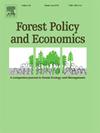重新审视苏格兰林地扩张以抵消碳的可行性
IF 3.8
2区 农林科学
Q1 ECONOMICS
引用次数: 0
摘要
本文开发了一个经济决策模型,以确定苏格兰目前用于畜牧业的土地上林地扩张的经济机会区域,评估其对实现净零目标的潜在贡献。利用高分辨率数据,该模型考虑了土壤碳储量、木材产量类别、牲畜放养率以及气候变化对树木生长的预估影响的空间变异性。研究结果表明,如果采用严格的环境和财政标准(旨在证明自愿碳市场的附加性),高达19.6%的苏格兰土地将适合林地扩张。在苏格兰8.4%到16.4%的土地上,林地扩张可能成为一种经济上有效的土地利用决策,碳价格从每吨二氧化碳10英镑到100英镑不等。在100年的平均水平上,这种潜在的扩张可能产生的碳抵消相当于苏格兰目前温室气体排放量的14%到23%。然而,通过更细致地了解碳平衡和持久性的动态,提高碳抵消的质量,可以显著减少林地扩张作为一种额外和有效的土地利用变化的面积,以及它对苏格兰净零目标的潜在贡献。本文章由计算机程序翻译,如有差异,请以英文原文为准。
Feasibility of woodland expansion for carbon offsetting in Scotland revisited
This paper develops an economic decision model to identify areas of economic opportunity for woodland expansion on land currently used for livestock farming in Scotland, assessing its potential contribution to achieving net-zero targets. Using high-resolution data, the model accounts for spatial variability in soil carbon stocks, timber yield classes, livestock stocking rates, and the projected impact of climate change on tree growth. The findings indicate that up to 19.6 % of Scottish land would be suitable for woodland expansion if strict environmental and financial criteria, aimed to demonstrate additionality in voluntary carbon markets, are applied. Woodland expansion could become an economically efficient land-use decision on 8.4 % to 16.4 % of Scottish land, for carbon prices ranging from £ 10 to £ 100 per CO2 tonne. Over a 100-year average, this potential expansion could yield carbon offsets equivalent to 14 % to 23 % of Scotland's current greenhouse gas emissions. However, improving the quality of carbon offsets through a more nuanced understanding of the dynamics of carbon balance and permanence over time significantly reduces both the area where woodland expansion is an additional and efficient land-use change and its potential contribution to Scotland's net-zero targets.
求助全文
通过发布文献求助,成功后即可免费获取论文全文。
去求助
来源期刊

Forest Policy and Economics
农林科学-林学
CiteScore
9.00
自引率
7.50%
发文量
148
审稿时长
21.9 weeks
期刊介绍:
Forest Policy and Economics is a leading scientific journal that publishes peer-reviewed policy and economics research relating to forests, forested landscapes, forest-related industries, and other forest-relevant land uses. It also welcomes contributions from other social sciences and humanities perspectives that make clear theoretical, conceptual and methodological contributions to the existing state-of-the-art literature on forests and related land use systems. These disciplines include, but are not limited to, sociology, anthropology, human geography, history, jurisprudence, planning, development studies, and psychology research on forests. Forest Policy and Economics is global in scope and publishes multiple article types of high scientific standard. Acceptance for publication is subject to a double-blind peer-review process.
 求助内容:
求助内容: 应助结果提醒方式:
应助结果提醒方式:


